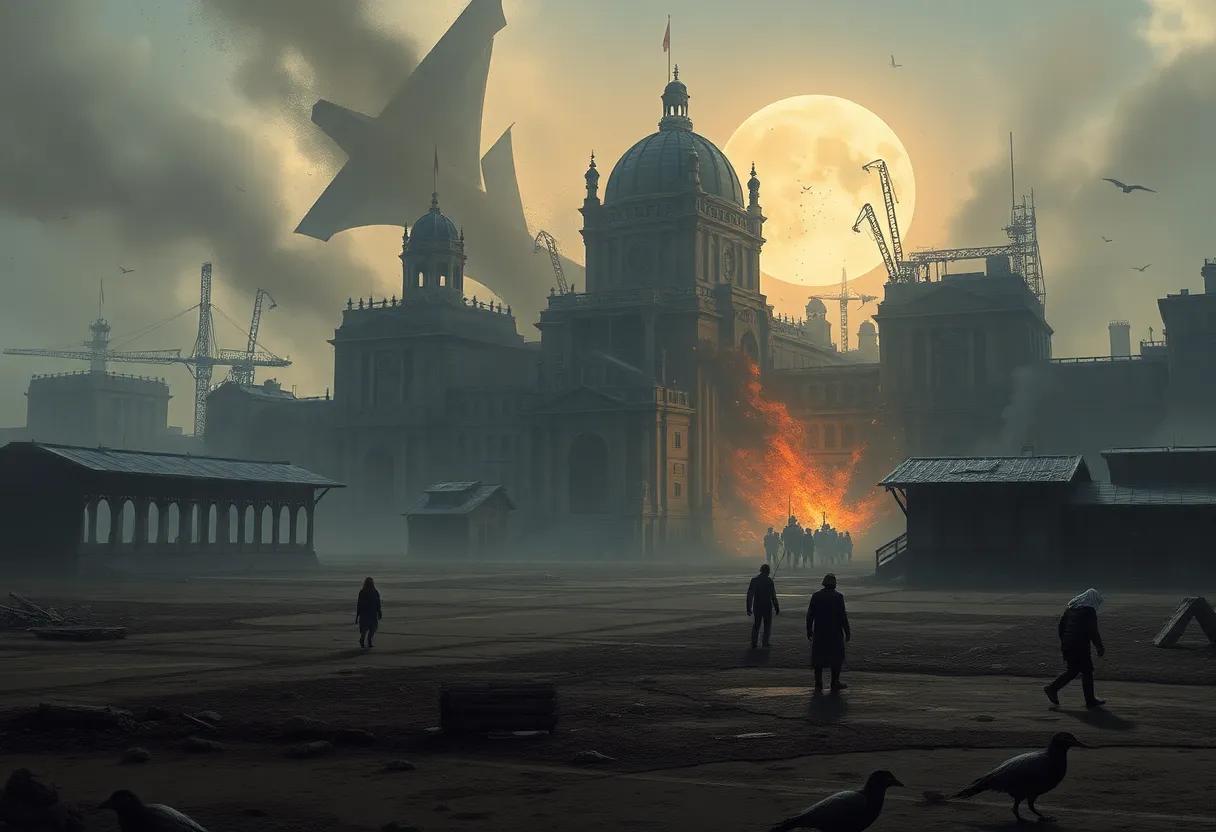In the realm of young adult dystopian fiction, Garth Nix’s Shade’s Children stands out as a gripping exploration of survival, identity, and resistance. delves into the layers of this dark, imaginative world where children are more than mere victims-they are the last flicker of hope against a merciless regime. This review seeks to illuminate the narrative’s strengths and complexities,inviting readers to reconsider not onyl the characters’ struggles but the broader themes Nix weaves into his haunting tale.
Unraveling the Dystopian World of Shade’s Children Through Vivid Imagery and Atmosphere
Garth Nix masterfully constructs a grim world where every shadow feels alive, and each breath carries a lingering sense of despair. Through vivid imagery, readers are immersed in desolate landscapes filled with ruined cities and eerie silences, where towering machines overshadow the remnants of humanity. This bleak backdrop becomes not just a setting but a character itself-an omnipresent force that tightens the grip of hopelessness. nix’s precise attention to atmospheric detail,from the cold metallic clangs to the flickering,unnatural light,pulls readers deeper into the dystopian reality,making the horrors Shine not through gore but through feeling.
what truly elevates the atmosphere is the subtle interplay of sensory details that stimulate the imagination without overwhelming it. The narrative frequently touches upon the contrast between the lingering warmth of lost childhood and the haunting emptiness of the world they inhabit. This is illustrated through moments like:
- The acrid smell of smoke mixed with the faint scent of wildflowers, hinting at pieces of a past now lost.
- The tactile coldness of steel cages, which imprison hopes and memories alike.
- The distant echo of mechanical footsteps, underscoring the omnipresence of relentless oppressors.
Such elements are meticulously woven to create a reader experience that goes beyond mere words. The oppressive atmosphere reflects the inner turmoil of the characters, all while propelling the narrative forward with an emotional gravity that is both haunting and unforgettable.
Exploring the Unique Narrative Structure That Engages Both Young and Mature Readers Alike
Garth Nix crafts a narrative in Shade’s Children that masterfully weaves urgency with introspection,creating a rhythm that captivates readers across age groups. The story unfolds through the eyes of multiple protagonists, each providing a distinct perspective that layers the dystopian world with rich emotional depth.This fragmented viewpoint invites readers to actively piece together the overarching mystery, encouraging engagement beyond passive reading. The interplay of action-driven sequences and contemplative moments cleverly balances excitement with thoughtfulness, making the narrative accessible without sacrificing complexity.
What truly sets this structure apart is its use of subtle shifts between hope and despair,mirrored through character decisions and world-building details. The chapters often end on ambiguous notes, prompting reflection and discussion-ideal for young readers developing critical thinking and mature readers appreciating nuanced storytelling. Consider how Nix structures the protagonists’ evolving relationships, survival tactics, and moral dilemmas through:
- Alternating character viewpoints
- Interspersed flashbacks
- Dynamic pacing that varies from frenetic to meditative
This method not only deepens connection with the characters but also constructs a layered narrative that resonates differently depending on the reader’s experience.
| Element | Effect |
|---|---|
| Multiple POVs | Broadens empathy and perspective |
| Non-linear Flashbacks | Builds suspense and reveals backstory |
| Pacing Variation | Keeps reader engagement dynamic |
Character Development and Emotional Depth Amidst a chaotic Post-Apocalyptic Setting
In the relentless whirlwind of Shade’s Children‘s dystopian landscape, Garth Nix masterfully breathes life into his characters, elevating them beyond mere survivors. Each protagonist is meticulously sculpted with layers of courage,vulnerability,and hope,making them profoundly relatable despite the desolation surrounding them. it’s within their interactions-whether forged in fleeting moments of trust or hardened by betrayal-that the narrative’s true heartbeat emerges. These young heroes embody the resilience of the human spirit,their personal growth unfolding naturally as they navigate a world stripped of innocence.
What distinguishes the emotional depth of this tale is its refusal to shy away from the raw, frequently enough painful, realities of loss and identity. The emotional arcs traverse complex territories, inviting readers to reflect on themes of autonomy, belonging, and the cost of survival. Here’s a snapshot of some key characters and their defining emotional traits:
| Character | Emotional Trait | Development Highlight |
|---|---|---|
| Shade | Protective | Embraces leadership despite self-doubt |
| Gold-Eye | Resilient | Transforms trauma into fierce determination |
| Lantern | Compassionate | Balances strength with empathy for others |
- Authentic emotions: No emotion feels superficial or forced, deepening the reader’s engagement.
- Nuanced relationships: Bonds and conflicts evolve naturally,reflecting real human complexity.
- Growth under pressure: Characters adapt and transform visibly in response to their harsh environment.
The Role of Technology and Memory in Shaping the Story’s Intriguing Conflict
In Shade’s Children, technology acts as both an oppressive force and a catalyst for rebellion, weaving a complex web that entraps the characters while simultaneously offering tools for resistance. The story’s dystopian landscape is heavily defined by the pervasive control of technology, which manipulates and erases memories, blurring the line between human identity and artificial influence.This technology-driven amnesia not only disorients the children but also deepens the mystery surrounding their pasts, compelling readers to question the reliability of memory itself as a foundation for truth and self-awareness.
Memory, fragmented and artificially suppressed, becomes a site of conflict where hope and despair collide. As the characters struggle to reclaim their stolen pasts, their fractured recollections act as symbols of resilience and loss. The tension rises as technology’s cold mechanisms clash with the raw, imperfect human will to remember and resist. Consider the dynamic below, which encapsulates the duel between these forces:
| Aspect | Technology | Memory |
|---|---|---|
| Function | Control and manipulation | Identity and resistance |
| Effect | Forgets, erases, destabilizes | recalls, reconstructs, empowers |
| Role in Conflict | Villainous enabler | Hopeful catalyst |
- Technology illustrates the dystopian hold on humanity, showcasing cold efficiency and control.
- Memory stands as an act of rebellion, a fragile yet potent source of strength and insight.
- The tension between these elements fuels the narrative, inviting readers to ponder the price of lost history in a techno-dominated world.
Themes of Survival, Hope, and Identity Interwoven Throughout the Plot with Subtle Precision
Within the labyrinthine narrative of Shade’s Children, survival emerges not merely as a backdrop but as a living, breathing force that shapes every character’s journey. The protagonists’ relentless struggle against an overwhelming dystopian regime is portrayed with subtlety and depth, avoiding clichéd tropes. Instead, Nix crafts moments where survival is both physical and psychological-each decision tinged with the weight of past losses and the fragile hope that tomorrow might bring freedom.This duality invites readers to ponder the resilience of the human spirit amid despair, painting survival as an evolving, multifaceted theme rather than a mere fight for existence.
Interwoven seamlessly with survival is the exploration of identity and hope,which act as quiet but persistent undercurrents throughout the story.Through the characters’ shifting self-perceptions and slowly rekindling dreams, hope becomes a tangible yet delicate thread that binds their fragmented world. The novel’s structure subtly mirrors these themes through its progression:
- Initial fragmentation: characters grapple with lost memories and shattered selves.
- Emerging Awareness: Clues and connections build a renewed sense of identity.
- Collective Resilience: Hope and camaraderie fuel their rebellion.
| Theme | Representation | Impact on Plot |
|---|---|---|
| Survival | Constant struggle, physical and mental endurance | Drives character decisions and plot urgency |
| Hope | Quiet resilience and aspirations for freedom | Motivates rebellion and unity |
| Identity | Lost memories and rediscovery of self | Shapes characters’ growth and alliances |
How Garth Nix Balances Dark Tones with Moments of Levity and optimism
Garth Nix masterfully intertwines the bleakness of a dystopian world with unexpected bursts of hope, ensuring readers are never engulfed entirely by darkness. His characters, though frequently enough battered by cruel circumstances, exhibit moments of genuine humor and resilience that break the tension with refreshing levity. These glimmers of optimism are not mere distractions but integral to the narrative’s heartbeat, reminding us that even in the direst settings, humanity endures.Small acts of kindness, witty banter amidst peril, and fleeting glimpses of friendship infuse the story with warmth without undermining its somber themes.
- Humor as a coping mechanism: Characters’ dry wit often shines when tension peaks, offering relief and deepening relatability.
- Symbolic moments of light: Brief scenes where hope flickers subtly, like the growth of a solitary plant or a child’s innocent question.
- Optimistic character arcs: Despite the oppressive environment, protagonists harbor dreams and ambitions that fuel their survival.
| Dark Element | Light Counterpart | Effect on Reader |
|---|---|---|
| Post-apocalyptic decay | Childlike wonder | Rekindles empathy and innocence |
| Relentless oppression | Resilient camaraderie | Builds hope and connection |
| Danger and violence | Moments of humor | Reduces despair and boosts engagement |
The impact of Shade’s Children on the Young Adult Science Fiction Genre and Its Legacy
shade’s Children carved a distinctive niche in the young adult science fiction landscape by weaving dystopian themes with complex moral questions rarely explored in YA during its time. Garth Nix’s portrayal of a post-apocalyptic world where children are both the victims and resistors to a sinister regime offered readers a fresh, gritty perspective that challenged conventional narratives. The novel’s unrelenting pace,paired with its raw emotional depth,raised the bar for character development in YA sci-fi,encouraging authors to push beyond simplistic heroics toward more nuanced protagonists wrestling with survival and identity. Its legacy is not just in story innovation but also in the way it paved the road for darker, more cerebral YA literature.
The influence of Shade’s Children extends beyond its storytelling. It inspired a generation of writers and readers to explore themes like autonomy, sacrifice, and the resilience of youth in the face of authoritarian control. The book’s blueprint is evident in later works that combine fast-paced action with philosophical undertones. For quick reference, here’s a summary comparison of its impact alongside other influential YA sci-fi novels:
| Title | Release Year | Key Contribution | Legacy Feature |
|---|---|---|---|
| Shade’s Children | 1997 | Dystopian youth survival | Dark themes in YA |
| The hunger Games | 2008 | Reality TV dystopia | Socio-political critique |
| Divergent | 2011 | Faction-based society | Identity and choice |
| Ender’s Game | 1985 | Child prodigy in war | Psychological depth |
- Pioneer of darker dystopian storytelling that respects the intelligence and emotional complexity of young readers.
- Encouraged themes of ethical ambiguity, pushing YA beyond black-and-white moralities.
- Inspired multimedia adaptations that explore youth resistance narratives.
A Close Look at the Symbolism Behind the Title and Its reflection Within the Story
the title shade’s Children serves as a powerful metaphor that promptly immerses readers into the novel’s somber atmosphere.The word ”Shade” evokes images of darkness and obscurity,alluding to both the literal shadows cast by the oppressive Futureworld regime and the figurative loss of innocence experienced by the children. it reflects the haunting existence of the youth who have been stripped away from their past lives and identities, living in the penumbra between hope and despair. in this context, shade becomes a symbol of survival amid obliteration-an area where light is dimmed, suggesting both danger and sanctuary.
Throughout the story, this symbolism deepens in layers, aligning with key themes such as resilience, memory, and resistance. The children,as “shades,” represent those who have been overshadowed by a tyrannical force yet refuse to vanish. This duality manifests in their struggles and alliances, embodying both the vulnerability of children and the determination of fighters. Consider the following elements that connect the title’s symbolism with the narrative:
- Loss and Identity: The children’s fragmented memories parallel the elusive nature of a shade-intangible, shifting, and incomplete.
- Resistance and Survival: Operating in the shadows underlines their clandestine battle against an overwhelming adversary.
- Hope and Change: Even in darkness, the shade hints at the possibility of emerging into light and reclaiming lost humanity.
| Symbol | Meaning | Story Reflection |
|---|---|---|
| Shade | Darkness & Shelter | Children hiding & surviving |
| Children | Innocence & Resilience | Fighting for future |
| Futureworld | Tyranny & Control | Oppressive regime |
The Evocative Language Style That Enhances Both Suspense and Empathy in Reader Experience
Garth Nix’s mastery of language in Shade’s Children is not just about plot progression; it’s a delicate dance between vivid imagery and raw emotion. His choice of words often grips the reader, plunging them into a world stripped of hope yet pulsating with fragile resilience. Through sharp, evocative descriptions, the bleakness of the dystopia becomes tangible, almost suffocating, while the nuanced inner thoughts of the characters breathe life into their struggles. Suspense doesn’t merely lurk around corners; it courses through every sentence, drawing readers deeper into a maze where danger and empathy collide.
What sets Nix apart is his ability to balance tension with a profound emotional connection,achieved through:
- Concise yet emotive prose that captures the immediacy of survival and fear.
- Symbolic language that invites readers to ponder the themes beyond the surface.
- Dialogue laced with subtext revealing the complexities of trust and loss.
This blend compels readers not only to anticipate the next twist but also to invest emotionally in the well-being of each child. Below is a brief comparison of how the language style shifts between moments of tension and empathy:
| moment | Language Style | Effect |
|---|---|---|
| Chasing danger | Sharp, fragmented sentences | Heightens urgency and breathlessness |
| Private reflections | Soft, lyrical phrasing | Fosters deep emotional connection |
| Interpersonal conflict | Subtle, charged dialogue | Reveals character depth and tension |
Specific Recommendations for readers Who Enjoy Thought-Provoking and Fast-Paced Dystopian Tales
For those captivated by dystopian worlds that spark both reflection and adrenaline, Shade’s Children offers a masterclass in balancing cerebral themes with relentless action. Garth Nix crafts a fragmented society where survival is not just physical but mental, forcing readers to question the nature of identity and control. If you appreciate complex moral dilemmas delivered through sharp,swift storytelling,this novel’s blend of dark innovation and gripping pacing will keep you riveted from first page to last. The characters’ fight against an oppressive regime resonates long after the final confrontation, inviting readers to ponder the cost of freedom and the resilience of hope.
To dive deeper into similar reading experiences, consider exploring the titles below, each echoing the intensity and intellectual depth found in Shade’s Children. Whether you lean toward tales of rebellious youth, dystopian survival, or intricate world-building that challenges your perspective, these selections align perfectly with what thoughtful, fast-paced dystopian fiction seeks to offer:
- “never Let Me Go” by Kazuo Ishiguro – A haunting exploration of humanity and memory wrapped in subtle dystopian elements.
- “The Maze Runner” by James Dashner – High-energy survival meets layered mysteries in a treacherous, controlled environment.
- “Station Eleven” by Emily St. John Mandel – A beautifully woven story of collapse and hope interspersed with philosophical musings.
- “Legend” by Marie lu – A gripping, fast-paced narrative driven by compelling protagonists in a fractured society.
Why Shade’s Children Remains Relevant in Contemporary Discussions About Humanity and Ethics
In an era where technological advancements and bioethics dominate global conversations, Shade’s Children serves as a poignant reminder of the delicate balance between progress and morality. Garth Nix’s dystopian world challenges readers to confront what it means to be human when society’s structures collapse into chaos and control is wielded without empathy. The novel’s portrayal of children as both victims and rebels sparks critical reflection on autonomy, consent, and the value of individual life amidst systemic exploitation. Through its raw depiction of survival, it raises enduring questions about the ethics of power – who holds it, who suffers under it, and how far one should go to reclaim humanity from dehumanization.
Moreover, the novel’s themes resonate deeply with contemporary debates surrounding identity, freedom, and the consequences of unchecked authority. The characters’ struggles underscore that ethical dilemmas are rarely black and white, embodying a spectrum of choices that test human resilience and morality. Key reflections include:
- The loss of innocence in oppressive environments
- The intersection of technology and ethical obligation
- Resistance as a form of reclaiming humanity
- The moral questions around survival and sacrifice
| Ethical Theme | contemporary Relevance |
|---|---|
| Dehumanization | AI ethics and societal marginalization |
| autonomy | Data privacy and consent laws |
| Power Imbalance | Government surveillance and control |
| Resistance | Activism and social justice movements |
Insights into Garth Nix’s Writing Journey and the Inspirations Behind Shade’s Children
garth Nix’s journey in crafting Shade’s Children is a interesting blend of imaginative world-building and deeply personal reflection. Inspired by dystopian themes and the resilience of youth, Nix draws upon both classic post-apocalyptic tropes and his own fascination with the delicate balance between hope and despair. It’s evident that the harsh environment of the novel was grounded in an exploration of how children, stripped of innocence and autonomy, navigate a world dominated by oppressive forces. His storytelling approach reveals a profound respect for the strength found in vulnerability, and also a desire to challenge conventional ideas about power structures and survival.
Delving deeper into his creative process,Nix highlights several key influences that shaped the narrative and tone of Shade’s Children. These include:
- Classic dystopian literature, which provided a foundation for exploring societal collapse and resistance.
- Science fiction cinema, inspiring the novel’s blend of bleak settings and technological darkness.
- Personal childhood reflections, giving the story its emotional core and nuanced character struggles.
- Mythological archetypes, especially those involving transformation and rebirth, echoing the children’s evolution within the story.
| Inspiration | Impact on Shade’s Children |
|---|---|
| Orwellian Dystopia | Framework for authoritarian control and rebellion |
| Cyberpunk Aesthetics | Dark, mechanized environments |
| Children’s Resilience | Focus on courage and teamwork |
| Mythic Motifs | Themes of transformation and survival |









